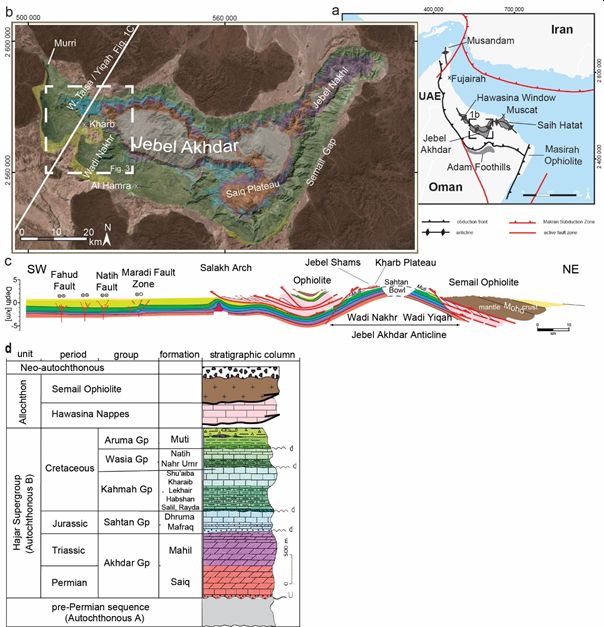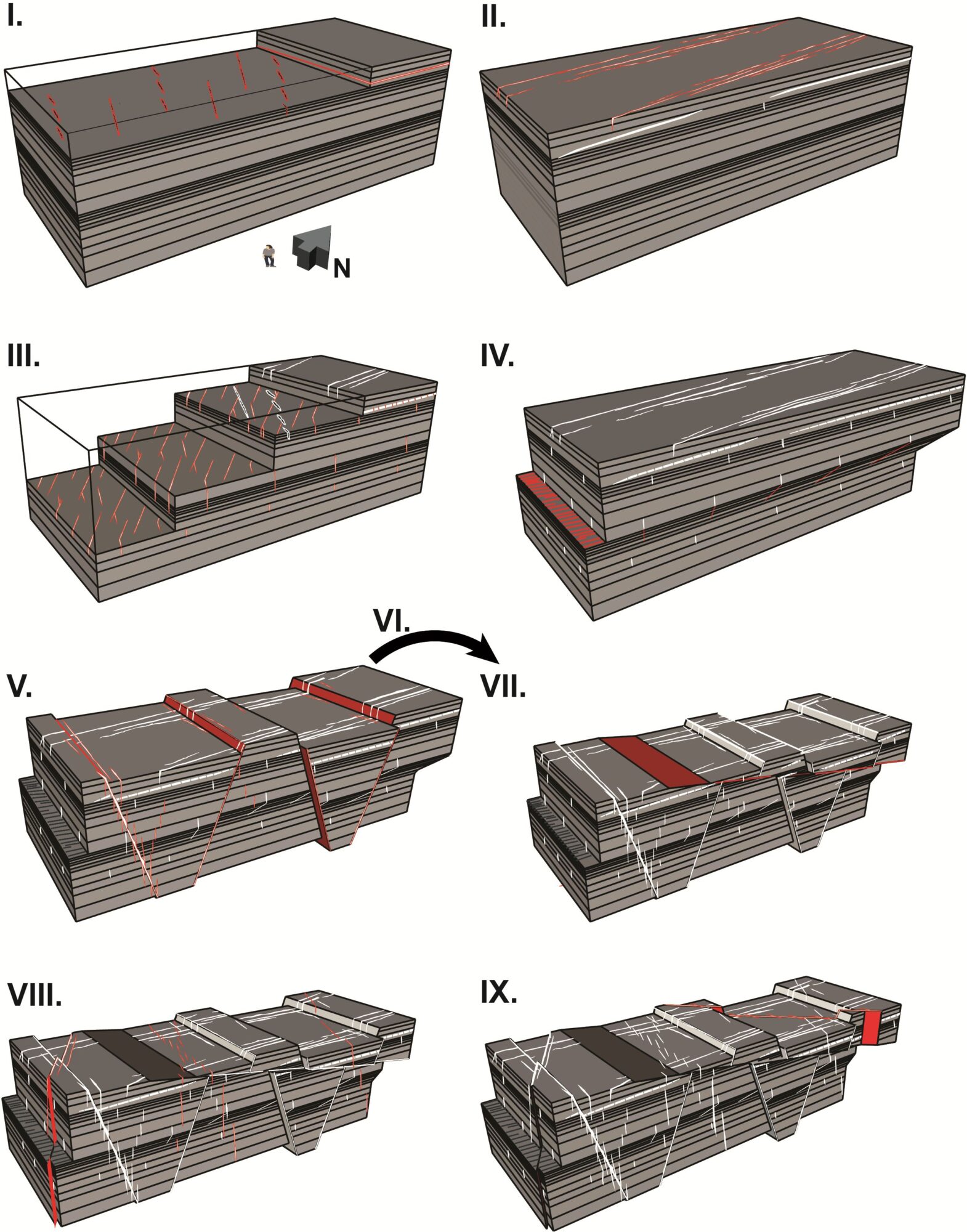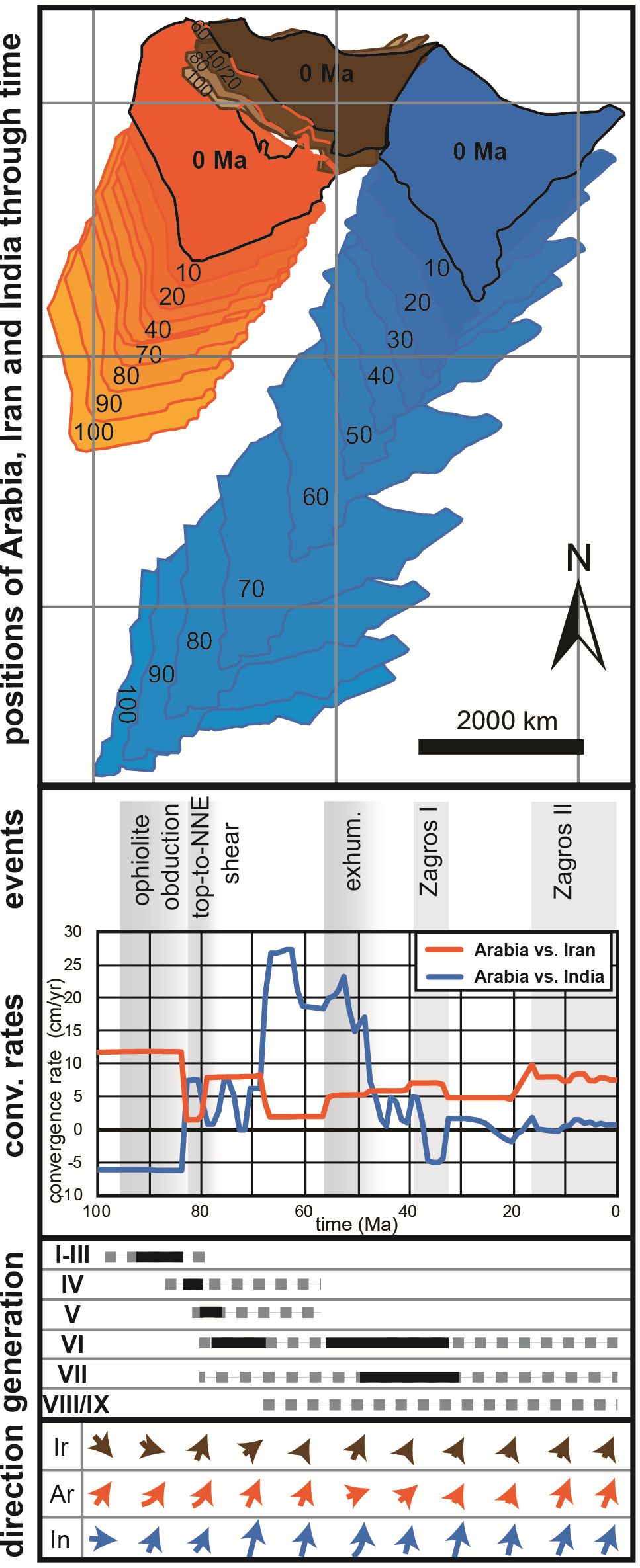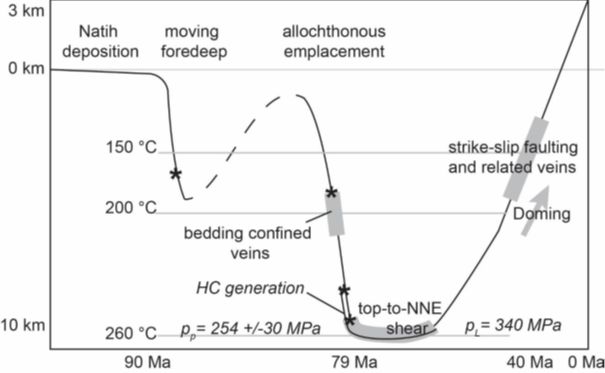OmanStruc
PIs: Christoph v.Hagke, Arne Grobe, Janos Urai
In this project we use a combination of (micro-)structural investigations with thermochronological age dating to constrain mountain building in Oman. This Project is in collaboration with Janos Urai, RWTH Aachen University
The structural evolution of the carbonate platform in the footwall of the Semail ophiolite emplaced onto the passive continental margin of Arabia helps to better understand the early stages of obduction-related orogens. These early stages are rarely observable in other orogens as they are mostly overprinted by later mountain building phases. We perform an extensive structural and thermochronologial analysis of the Jebel Akhdar anticline, the largest tectonic window of the Oman Mountains and integrate it on different scales. Outcrop observations can be linked to plate motion data, providing an absolute timeframe for structural generations.

- a) Location and tectonic framework of the Oman Mountains. Three tectonic windows, Hawasina, Jebel Akhdar and Saih Hatat (1: As Sifah, 2: Wadi Mayh) are shaded in gray. Black lines denote front of the Semail and Masirah Ophiolites. Red lines denote lithosphere-scale structures. b) Geologic map of the Jebel Akhdar window. Colors correspond to the stratigraphic chart of Figure 1d. c) A structural transect of the Jebel Akhdar anticline (compiled from Al-lazki et al., 2002; Filbrandt et al., 2006; Searle, 2007). d) Stratigraphy of the carbonate platform as observed in the Jebel Akhdar.

Block diagrams highlighting mapped structures and their relative evolution (I-IX), active structures are depicted in red, older structures in white. Mode-I, bedding confined calcite veins formed striking E-W (I), N-S (II) and NW-SE (III) and might represent anti-clockwise platform rotation. Normal faults form horst-graben structures and offset early veins (IV). Doming represent generation V before top-to-NNE shear (VI) offsets faults and deforms the veins. NNE-ward increasing shear strain is observed at successively sheared veins. Low-angle, top-to-NE normal faults (VII) offset normal faults and shear affected structures. At latest strike slip reactivations overprint all structures (VIII, IX).

GPlates reconstruction of plate motions from 100 Ma to present day. Extracted convergence rates are linked with the interpretation of events and our mapped structural generations. Arrows illustrate the direction of plate motion.

Summary burial sketch for the top of the carbonate platform (Natih Fm.). Shown temperatures are based on RSCM and FI thermometry, pressure data calculated out of FI measurements and independently determined temperature data. The uplift history is restored by ZHe ages. (* indicate times of overpressure formation, gray areas depict vein formation)
Further Reading:Grobe, A.,
von Hagke, C., Littke, R., Dunkl, I.; Wübbeler, F.; Muchez, P.; Urai, J.L., (2019): Evolution of Oman’s Mesozoic passive continental margin under the obducting Semail Ophiolite – a basin modeling study of pressure, temperature and tectonically expelled fluids in the Jebel Akhdar, Oman, Solid Earth 10, pp.149-175Grobe, A., Virgo, S.,
von Hagke, C., Urai, J.L., Littke, R. (2018):
Multiphase structural evolution of a continental margin during obduction orogeny: insights from the Jebel Akhdar Dome, Oman Mountains, Tectonics 37. doi: 10.1002/2016TC004442von Hagke, C., Wellmann, J. F., Urai, J.L. (2019):
From Google Earth to 3-D Geology Problem 1: Understanding structures and generating geological maps using Google Earth, Developments in Structural Geology and Tectonics 5, pp.181-188Wellmann, J. F. Schaaf, A., de la Varga, M.,
von Hagke, C., (2019),
From GoogleEarth to 3-D Geology Problem 2: Seeing below the surface of the Digital Earth, Developments in Structural Geology and Tectonics 5, pp.189-204
 Block diagrams highlighting mapped structures and their relative evolution (I-IX), active structures are depicted in red, older structures in white. Mode-I, bedding confined calcite veins formed striking E-W (I), N-S (II) and NW-SE (III) and might represent anti-clockwise platform rotation. Normal faults form horst-graben structures and offset early veins (IV). Doming represent generation V before top-to-NNE shear (VI) offsets faults and deforms the veins. NNE-ward increasing shear strain is observed at successively sheared veins. Low-angle, top-to-NE normal faults (VII) offset normal faults and shear affected structures. At latest strike slip reactivations overprint all structures (VIII, IX).
Block diagrams highlighting mapped structures and their relative evolution (I-IX), active structures are depicted in red, older structures in white. Mode-I, bedding confined calcite veins formed striking E-W (I), N-S (II) and NW-SE (III) and might represent anti-clockwise platform rotation. Normal faults form horst-graben structures and offset early veins (IV). Doming represent generation V before top-to-NNE shear (VI) offsets faults and deforms the veins. NNE-ward increasing shear strain is observed at successively sheared veins. Low-angle, top-to-NE normal faults (VII) offset normal faults and shear affected structures. At latest strike slip reactivations overprint all structures (VIII, IX).
 GPlates reconstruction of plate motions from 100 Ma to present day. Extracted convergence rates are linked with the interpretation of events and our mapped structural generations. Arrows illustrate the direction of plate motion.
GPlates reconstruction of plate motions from 100 Ma to present day. Extracted convergence rates are linked with the interpretation of events and our mapped structural generations. Arrows illustrate the direction of plate motion.
 Summary burial sketch for the top of the carbonate platform (Natih Fm.). Shown temperatures are based on RSCM and FI thermometry, pressure data calculated out of FI measurements and independently determined temperature data. The uplift history is restored by ZHe ages. (* indicate times of overpressure formation, gray areas depict vein formation)
Further Reading:Grobe, A., von Hagke, C., Littke, R., Dunkl, I.; Wübbeler, F.; Muchez, P.; Urai, J.L., (2019): Evolution of Oman’s Mesozoic passive continental margin under the obducting Semail Ophiolite – a basin modeling study of pressure, temperature and tectonically expelled fluids in the Jebel Akhdar, Oman, Solid Earth 10, pp.149-175Grobe, A., Virgo, S., von Hagke, C., Urai, J.L., Littke, R. (2018): Multiphase structural evolution of a continental margin during obduction orogeny: insights from the Jebel Akhdar Dome, Oman Mountains, Tectonics 37. doi: 10.1002/2016TC004442von Hagke, C., Wellmann, J. F., Urai, J.L. (2019): From Google Earth to 3-D Geology Problem 1: Understanding structures and generating geological maps using Google Earth, Developments in Structural Geology and Tectonics 5, pp.181-188Wellmann, J. F. Schaaf, A., de la Varga, M., von Hagke, C., (2019), From GoogleEarth to 3-D Geology Problem 2: Seeing below the surface of the Digital Earth, Developments in Structural Geology and Tectonics 5, pp.189-204
Summary burial sketch for the top of the carbonate platform (Natih Fm.). Shown temperatures are based on RSCM and FI thermometry, pressure data calculated out of FI measurements and independently determined temperature data. The uplift history is restored by ZHe ages. (* indicate times of overpressure formation, gray areas depict vein formation)
Further Reading:Grobe, A., von Hagke, C., Littke, R., Dunkl, I.; Wübbeler, F.; Muchez, P.; Urai, J.L., (2019): Evolution of Oman’s Mesozoic passive continental margin under the obducting Semail Ophiolite – a basin modeling study of pressure, temperature and tectonically expelled fluids in the Jebel Akhdar, Oman, Solid Earth 10, pp.149-175Grobe, A., Virgo, S., von Hagke, C., Urai, J.L., Littke, R. (2018): Multiphase structural evolution of a continental margin during obduction orogeny: insights from the Jebel Akhdar Dome, Oman Mountains, Tectonics 37. doi: 10.1002/2016TC004442von Hagke, C., Wellmann, J. F., Urai, J.L. (2019): From Google Earth to 3-D Geology Problem 1: Understanding structures and generating geological maps using Google Earth, Developments in Structural Geology and Tectonics 5, pp.181-188Wellmann, J. F. Schaaf, A., de la Varga, M., von Hagke, C., (2019), From GoogleEarth to 3-D Geology Problem 2: Seeing below the surface of the Digital Earth, Developments in Structural Geology and Tectonics 5, pp.189-204



